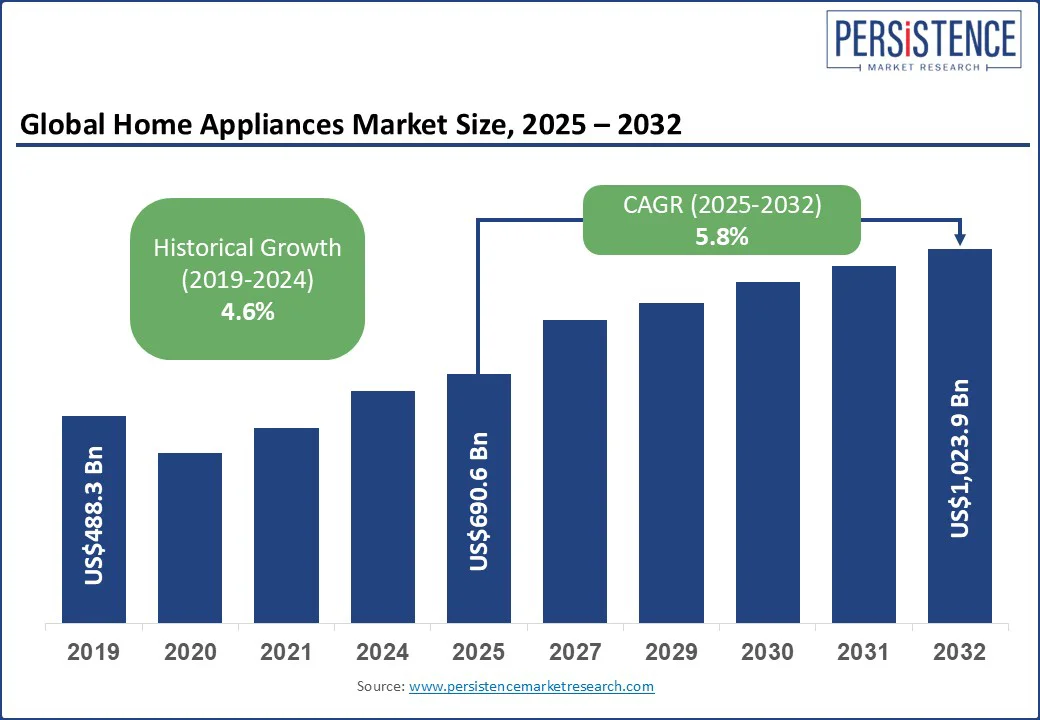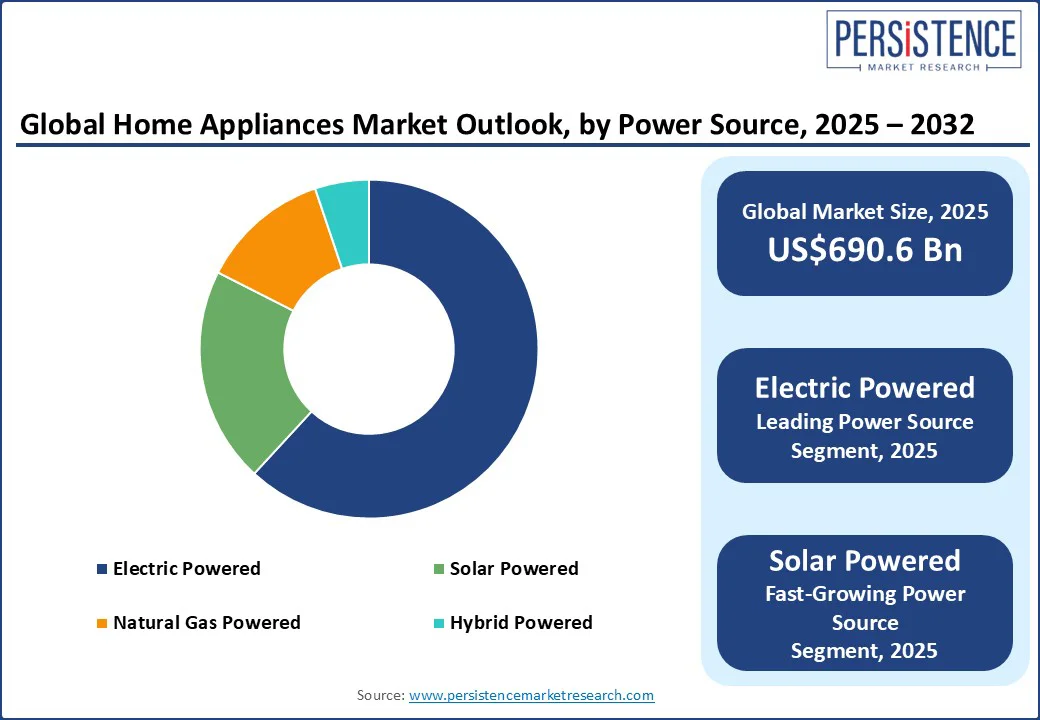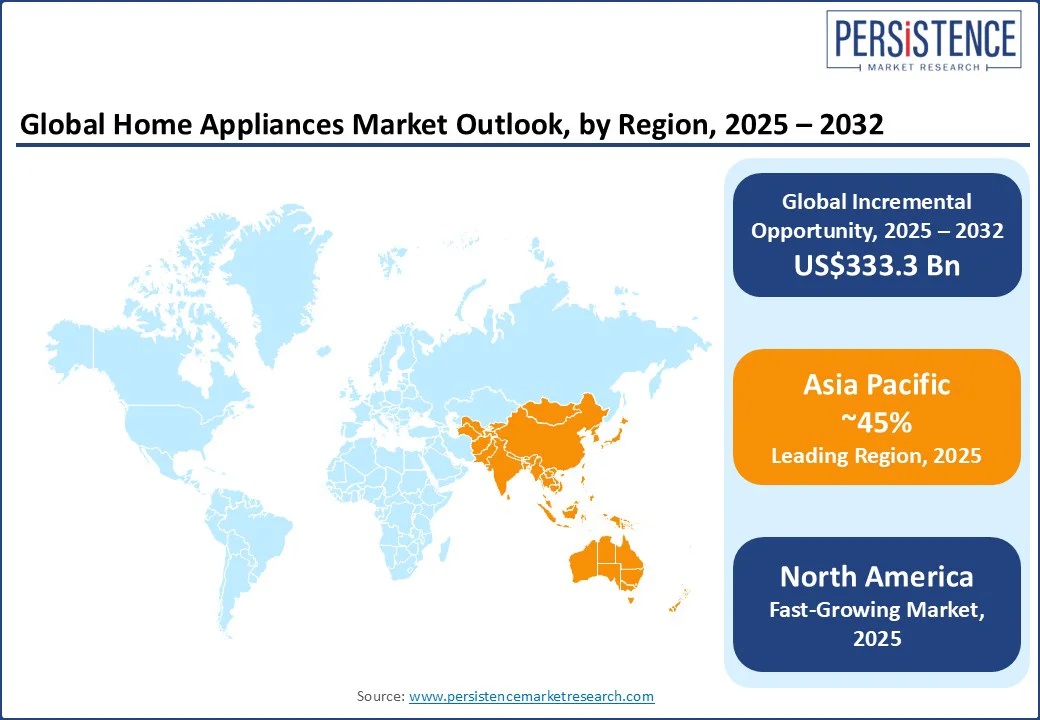ID: PMRREP20566| 193 Pages | 21 Aug 2025 | Format: PDF, Excel, PPT* | Consumer Goods

The global home appliances market size is projected to rise from US$690.6 Bn in 2025 to US$1,023.9 Bn by 2032. It is anticipated to witness a CAGR of 5.8% during the forecast period from 2025 to 2032.
The growing need for convenience, sustainability, and digital integration in daily life is driving demand for appliances that can optimize energy usage, enable remote operation, and seamlessly integrate with IoT ecosystems. This evolution reflects a broader consumer shift toward lifestyle enhancement, automation, and environmental responsibility.
Key Industry Highlights

|
Global Market Attribute |
Key Insights |
|
Home Appliances Market Size (2025E) |
US$690.6 Bn |
|
Market Value Forecast (2032F) |
US$ 1,023.9 Bn |
|
Projected Growth (CAGR 2025 to 2032) |
5.8% |
|
Historical Market Growth (CAGR 2019 to 2024) |
4.6% |
With increasing consumer spending, more consumers are prioritizing comfort and convenience within their households, leading to a steady rise in demand for modern connected home appliances. As living standards improve, people are more willing to spend on products that simplify daily chores, enhance efficiency, and support a better quality of life. This shift is driving the adoption of smart and energy-efficient appliances such as automated washing machines and air purifiers.
For instance, in India, private consumption, driven by rising incomes, accounts for approximately 60% of GDP. The government’s recent tax reforms, including raising the no-tax threshold from INR 700,000 to INR 1.28 Mn (US$8,430 to US$15,422) in February 2025, are projected to inject additional purchasing power into 25-30 million taxpayers, directly boosting demand for essential and aspirational goods such as refrigerators, washing machines, and other household appliances.
This impact was evident in FY25 when average monthly spending on consumer durables in India jumped 72%, a rise from just 6% in FY24, as households purchased appliances to furnish new homes, as per online sources.
Home appliance manufacturers across the globe, particularly in key production hubs including China, are grappling with rising input costs for essential materials such as steel, aluminum, plastics, and electronic components. Steel and aluminum, which are core materials used across nearly all appliance categories, have experienced sharp price increases, directly inflating manufacturing expenses and squeezing producer margins.
In the U.S., cost pressures have been further exacerbated by new tariff policies introduced in June 2025. A 50% tariff now applies to the steel and aluminum content of major appliances such as refrigerators, washers, and stoves, even if they are assembled domestically using imported materials. As a result, appliance brands including Thermador, Bosch, LG, GE, and Chinese OEMs have raised prices by 5-25% in early 2025. This impact is particularly pronounced in the cooking and refrigeration segments, which are heavily dependent on imported steel and compressor components.
Consumers are increasingly seeking home appliances that go beyond traditional functionality to communicate, adapt, and optimize within broader smart home networks. This shift is propelled by the rapid growth of IoT infrastructure, with over 15.7 billion connected devices globally as of 2024, and projections pointing to over 38.8 billion by 2029.
As a result, appliances are evolving into intelligent nodes within integrated digital living environments. Leading brands, including Samsung and LG, are leading this transformation through platforms such as SmartThings and ThinQ, which enable AI-driven, cross-device communication across appliances such as refrigerators, ovens, washers, and HVAC systems.
In 2024, LG also acquired Athom, a smart home integration company, showing its focus on building a stronger smart home ecosystem. This move supports open standards such as Matter, Zigbee, and Thread, which help devices from different brands work together.
The launch of the Matter 1.4 standard in late 2024 was a major step in making smart appliances more compatible with platforms such as Amazon Alexa, Google Home, and Apple HomeKit. This advancement reduces consumer dependence on a single brand while creating new growth avenues for appliance makers.
The home appliances market has witnessed a significant shift toward energy-efficient and sustainable products, driven by growing environmental concerns, rising utility costs, and stricter energy regulations. Consumers increasingly prefer appliances that reduce energy consumption without compromising performance. Governments are implementing stricter standards and labeling systems, such as the EU’s Ecodesign Directive and A-G energy labels with QR codes, enabling households to save € 182-€ 266 annually (US$200 - US$ 293 annually), expected to reach € 736 (US$ 810) by 2030.
From July 2025, the EU will allow only energy-efficient heat-pump dryers, accelerating the transition toward low-consumption appliances. In the U.S., the ENERGY STAR program continues to shape the market, with certified appliances saving over 5 trillion kWh and avoiding US$500 Bn in energy costs. Major players such as Samsung, the ENERGY STAR Partner, of energy-saving features, including AI-powered modes and smart grid compatibility.
Based on the power source, the market is segmented into electric powered, solar powered, natural gas powered, and hybrid powered. Among these, the electric-powered segment is anticipated to dominate with an estimated share of more than 60% in 2025. This growth is attributed to their compatibility with established power infrastructure, along with their support for automation, energy efficiency, and connectivity. The increasing shift away from gas and other non-renewable sources, particularly in developed and developing regions, is aimed at reducing carbon emissions. Countries including India and China have rapidly expanded rural electrification programs, significantly increasing household access to electric-powered appliances.
The solar-powered segment is expected to grow at the highest rate due to increasing consumer demand for sustainable and energy-efficient solutions, supported by falling solar panel costs and government incentives. Rising electricity prices and growing awareness of carbon footprints are also accelerating adoption. Countries such as India and Australia witness a rapid adoption, with India adding over 12 GW of solar capacity in the first half of 2024 alone.
Based on the distribution channel, the market is segmented into offline and online. Offline distribution channels are likely to dominate, accounting for approximately 65% of total sales in 2025, despite the rapid rise of online retail. Consumers prefer physical stores such as brand showrooms, electronics chains, and multi-brand outlets for hands-on product experience, size and design assessment, and personalized assistance. Offline purchases are also favored due to logistical factors such as installation, delivery coordination, and after-sales service support offered by retailers.
Online sales are expected to grow at a significant rate due to increasing internet penetration, smartphone usage, and digital payment adoption. E-commerce platforms offer wider product choices, competitive pricing, doorstep delivery, and easy return policies, making them highly convenient. The rise of virtual product demos and AI-powered recommendations enhances the online shopping experience, even for high-value items.

Asia Pacific is anticipated to be the dominant and fastest-growing region in the global home appliances market, accounting for approximately 45% share in 2025. This growth is driven by rapid urbanization, rising disposable incomes in China and India, evolving consumer preferences, and strong policy support. China is projected to lead the region, contributing over 50% of appliance sales. In 2024, its national “trade-in” subsidy program spurred the replacement of old appliances with smart, energy-efficient models, benefiting 36 million consumers and generating ¥240 billion (US$ 1.66 Bn) in sales. This helped drive a 22% year-over-year growth in appliance sales in November 2024 alone.
In addition to robust domestic demand, China remains a global manufacturing hub, exporting 4.48 billion units in 2024, a 20.8% rise year-over-year, mainly to North America, Europe, and Southeast Asia. India, though smaller in market size, is growing at an even faster pace. Backed by government incentives and rising urban incomes, Indian consumers spent over INR60,000 crore (US$ 7.23 Bn) on large appliances and TVs through offline channels in urban areas during the first half of 2024, while rural areas contributed INR3,000 crore (US$ 361.45 Mn) in sales during the same period.
Europe stands as a significant region in the home appliances market, driven by strong manufacturing capabilities, progressive energy policies, and impactful environmental regulations. The European Union hosts approximately 130 appliance manufacturing facilities, collectively supporting over 1 million jobs across the continent. According to a study, over 75% of large appliances and 50% of small appliances sold in Europe are produced within the EU itself, reinforcing the region’s industrial self-reliance and economic importance.
The EU’s Ecodesign Directive and Energy Labelling regulations, in effect since the mid-1990s and continually updated, have been credited with reducing average annual household energy consumption by up to 60% for refrigerators and freezers, along with consumer projections reaching €150 billion (US$ 163.5 Bn) by 2030. A 2024 Eurobarometer survey found that over 93% of European consumers recognize energy labels, and 75% say these labels influence their buying decisions, highlighting a strong preference for energy-efficient, eco-friendly appliances across the region.?
North America holds a significant position due to high per-household appliance ownership, strong consumer purchasing power, and a mature market with steady replacement demand. Consumers in the region consistently seek smart and energy-efficient appliances, supported by regulatory frameworks including the U.S. ENERGY STAR program. As of 2024, this initiative has helped American households save over US$ 40 Bn, underlining widespread adoption of eco-friendly technologies and government backing for energy conservation.
Incentive programs such as rebates on efficient refrigerators and heat-pump dryers are encouraging consumers to upgrade to modern appliances. At the same time, the increasing popularity of IoT-enabled home devices is fostering innovation and expanding product offerings. These trends, combined with rising awareness of energy savings and sustainability, continue to make North America a vital and evolving market.

The global home appliances market is fragmented, with major players such as Samsung, LG, Whirlpool, Haier, and Midea holding significant shares. Companies focus on continuous innovation in smart and energy-efficient technologies, aggressive pricing, strong brand positioning, and expanding their distribution and after-sales networks.
Companies are also leveraging e-commerce platforms to boost customer reach and loyalty. For example, in June 2025, GE Appliances announced a US$ 490 Mn investment in a new laundry facility in Kentucky, creating 800 jobs to support its advanced washer/dryer lines.
The home appliances market is projected to be valued at US$ 690.6 Bn in 2025.
The growing need for convenience, energy efficiency, and smart technology integration in daily household tasks is driving the home appliances market.
The home appliances market is poised to witness a CAGR of 5.8% from 2025 to 2032.
The growing demand for smart and connected appliances, driven by urbanization, digitalization, and sustainability initiatives, presents key market opportunities.
Whirlpool Corporation, Haier Smart Home Co., Ltd., LG Electronics Inc., Samsung Electronics Co., Ltd., Bosch Home Appliances, Electrolux AB, GE Appliances are the leading key players.
|
Report Attribute |
Details |
|
Historical Data/Actuals |
2019 - 2024 |
|
Forecast Period |
2025 - 2032 |
|
Market Analysis |
Value: US$ Bn |
|
Geographical Coverage |
|
|
Segmental Coverage |
|
|
Competitive Analysis |
|
|
Report Highlights |
|
|
Customization and Pricing |
Available upon request |
By Product Type
By Power Source
By Distribution Channel
By Region
Delivery Timelines
For more information on this report and its delivery timelines please get in touch with our sales team.
About Author